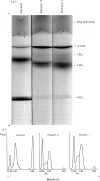Abstract
Clusterin (apolipoprotein J, SP-40,40), as well as apolipoprotein A-I (apo A-I) and apolipoprotein A-II (apo A-II), are apolipoprotein components of high density lipoprotein (HDL), but not of low density lipoprotein. In spite of the deficiencies of apo A-I, apo A-II and HDL in the sera of patients with Tangier disease, clusterin was found in them at normal level. While clusterin was present as the component of HDL with apo A-I in sera of normal donors, it was present as a protein which did not form a complex in sera of Tangier patients. SC5b-9 made from the sera of Tangier patients contained normal amounts of clusterin and was deficient in apo A-I, indicating that clusterin could be incorporated into the SC5b-9 complex without apo A-I. The complement activities of the sera of the patients were higher than those of normal donors. These results may be explained by the deficiencies of apo A-I, apo A-II and HDL in the patients, because they were suggested to be the inhibitors of the reactive haemolysis of complement. The elevated complement activities of the patients might be related to the severe atherosclerotic lesions in Tangier disease.
Full text
PDF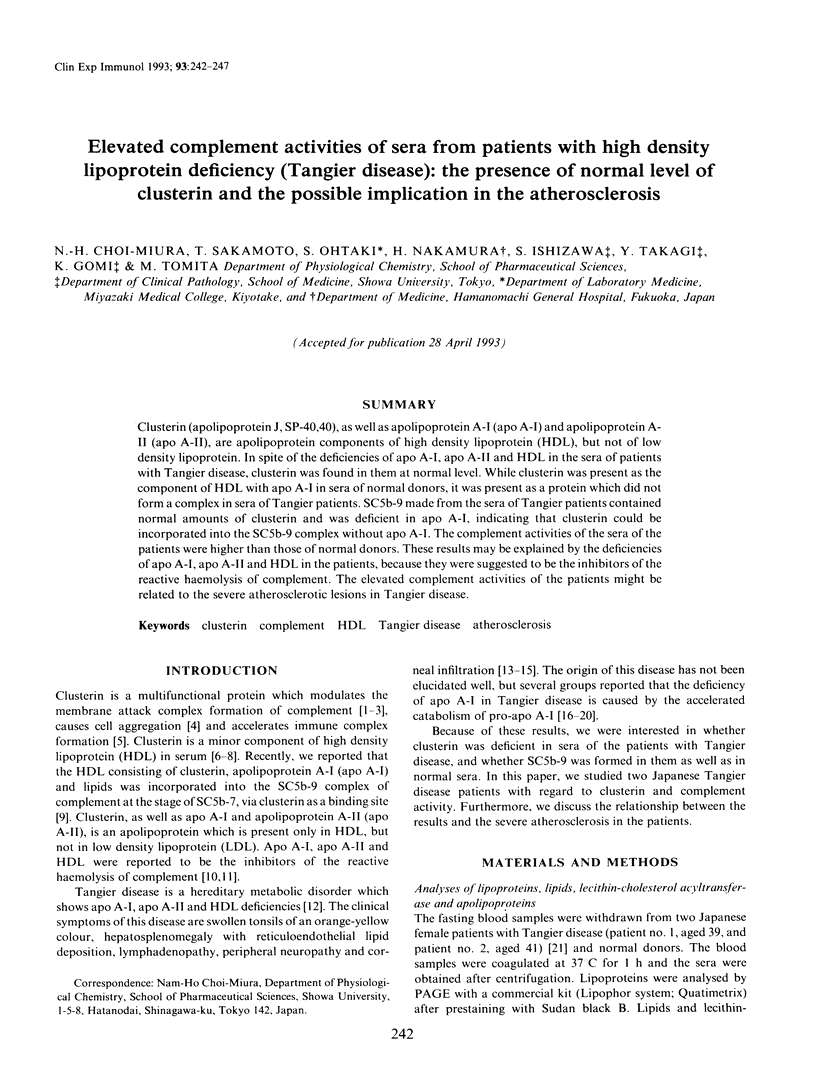
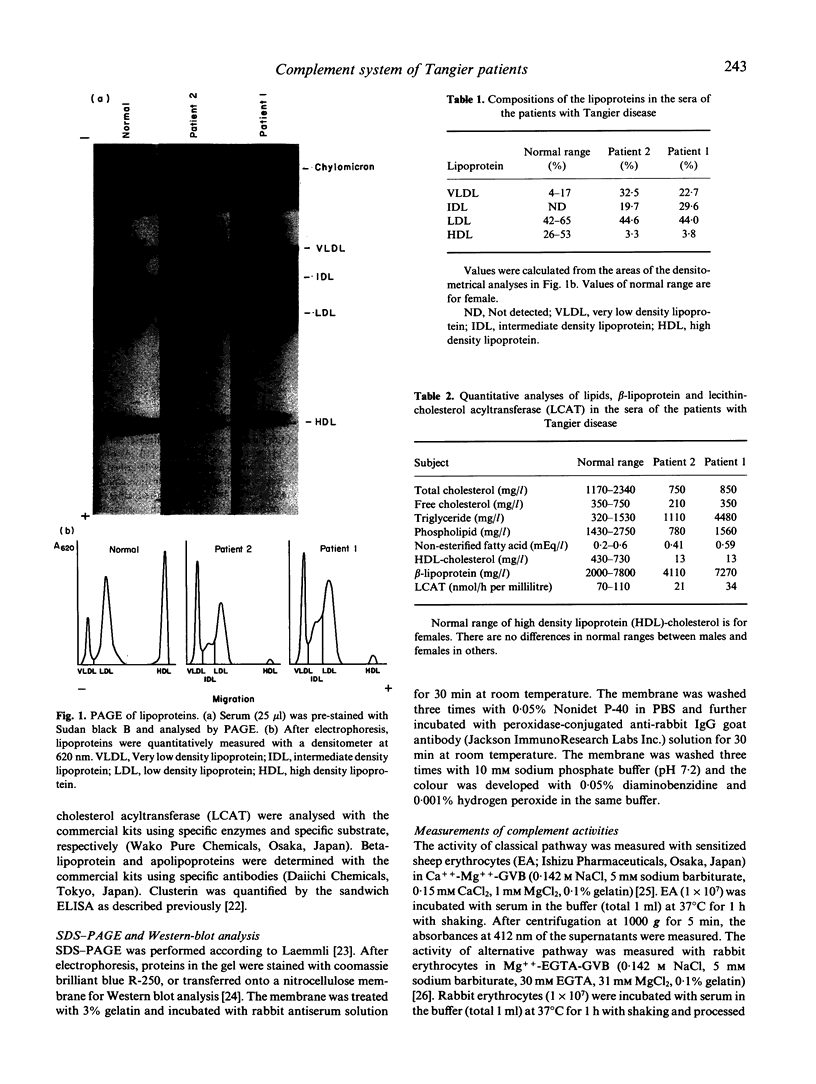
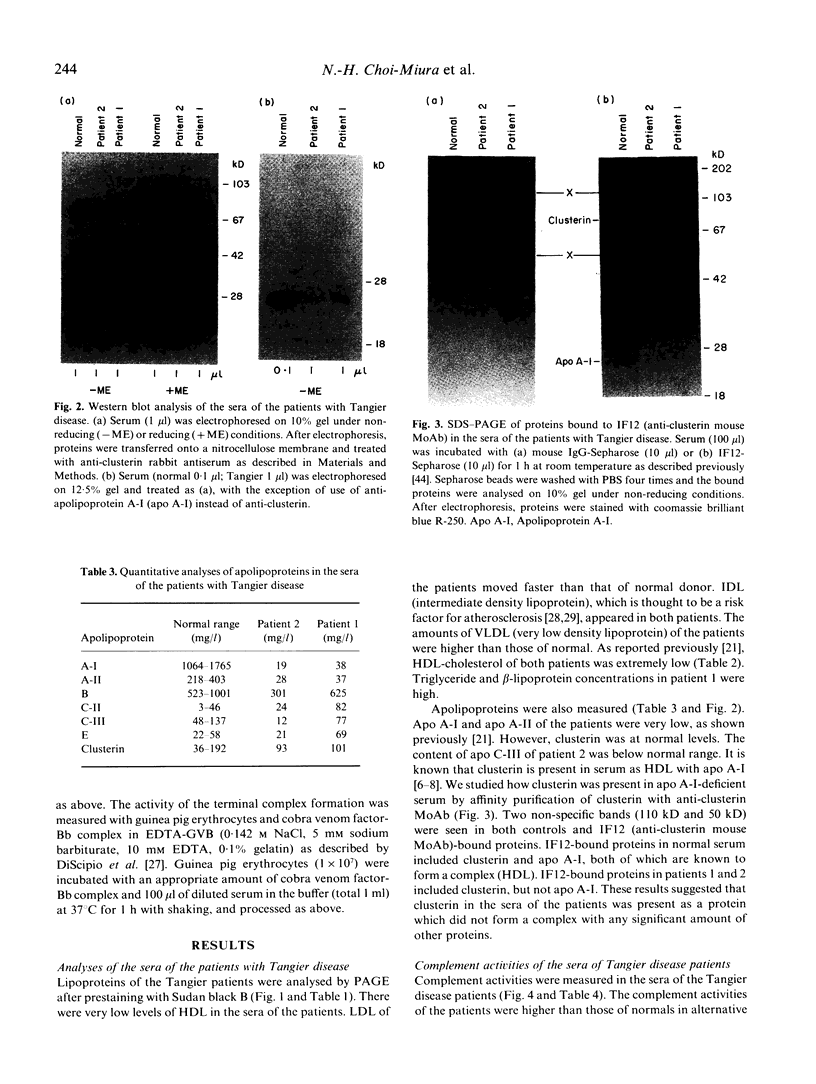
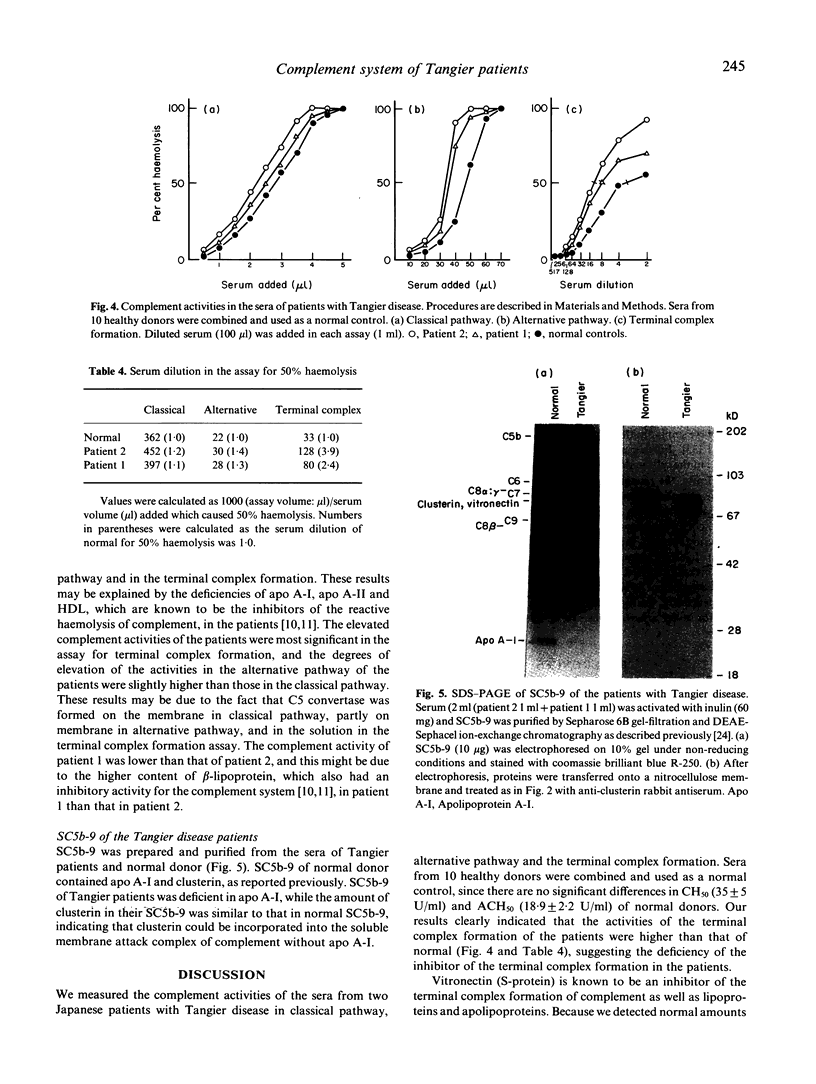
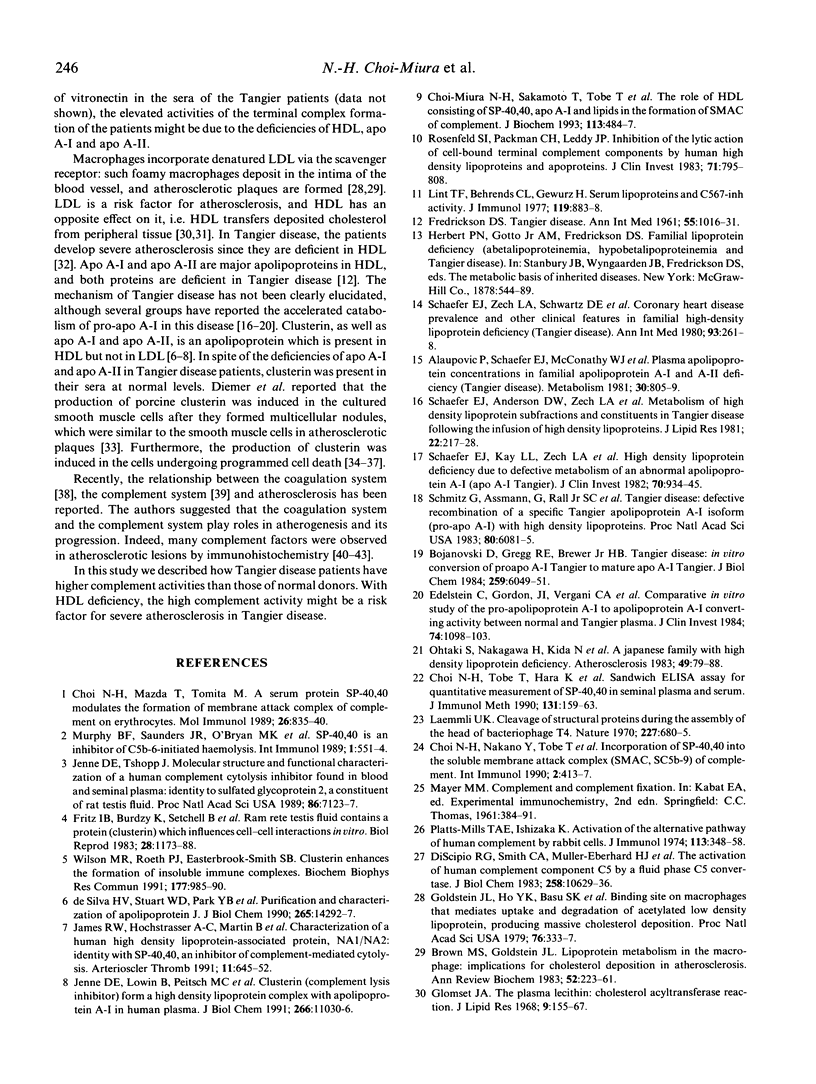
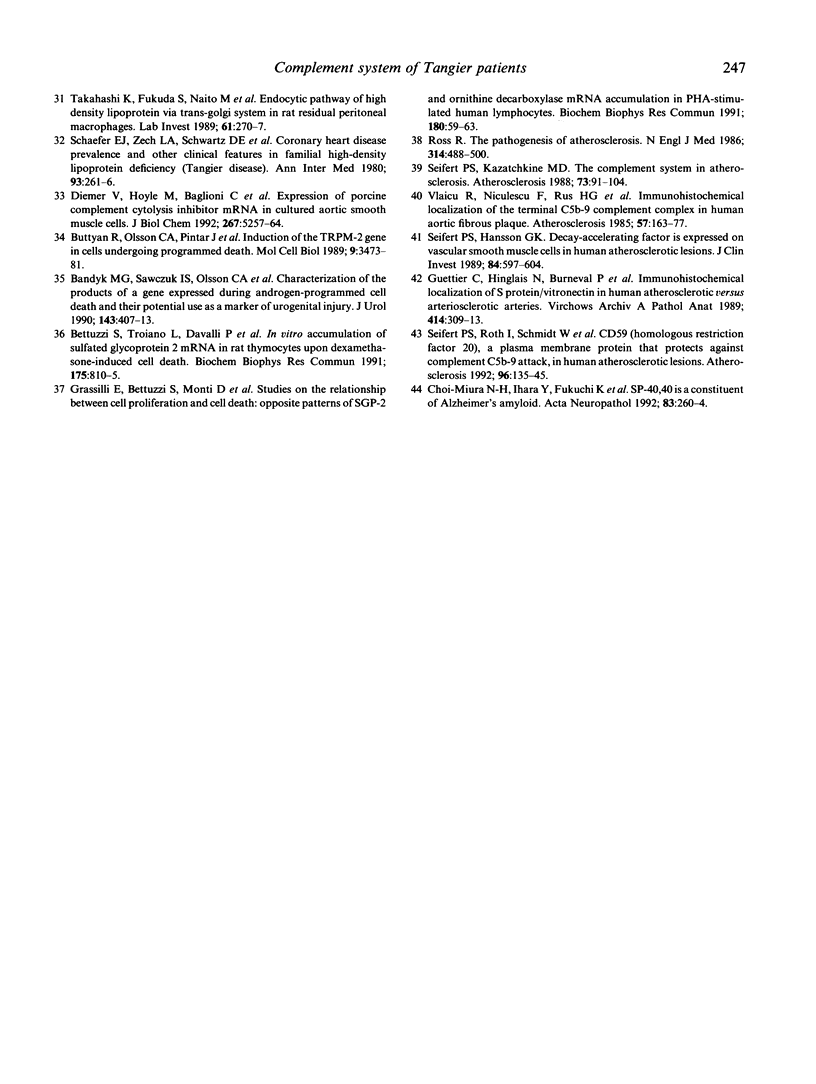
Images in this article
Selected References
These references are in PubMed. This may not be the complete list of references from this article.
- Alaupovic P., Schaefer E. J., McConathy W. J., Fesmire J. D., Brewer H. B., Jr Plasma apolipoprotein concentrations in familial apolipoprotein A-I and A-II deficiency (Tangier disease). Metabolism. 1981 Aug;30(8):805–809. doi: 10.1016/0026-0495(81)90027-5. [DOI] [PubMed] [Google Scholar]
- Bandyk M. G., Sawczuk I. S., Olsson C. A., Katz A. E., Buttyan R. Characterization of the products of a gene expressed during androgen-programmed cell death and their potential use as a marker of urogenital injury. J Urol. 1990 Feb;143(2):407–413. doi: 10.1016/s0022-5347(17)39975-5. [DOI] [PubMed] [Google Scholar]
- Bettuzzi S., Troiano L., Davalli P., Tropea F., Ingletti M. C., Grassilli E., Monti D., Corti A., Franceschi C. In vivo accumulation of sulfated glycoprotein 2 mRNA in rat thymocytes upon dexamethasone-induced cell death. Biochem Biophys Res Commun. 1991 Mar 29;175(3):810–815. doi: 10.1016/0006-291x(91)91637-r. [DOI] [PubMed] [Google Scholar]
- Bojanovski D., Gregg R. E., Brewer H. B., Jr Tangier disease. In vitro conversion of proapo-A-ITangier to mature APO-A-ITangier. J Biol Chem. 1984 May 25;259(10):6049–6051. [PubMed] [Google Scholar]
- Brown M. S., Goldstein J. L. Lipoprotein metabolism in the macrophage: implications for cholesterol deposition in atherosclerosis. Annu Rev Biochem. 1983;52:223–261. doi: 10.1146/annurev.bi.52.070183.001255. [DOI] [PubMed] [Google Scholar]
- Buttyan R., Olsson C. A., Pintar J., Chang C., Bandyk M., Ng P. Y., Sawczuk I. S. Induction of the TRPM-2 gene in cells undergoing programmed death. Mol Cell Biol. 1989 Aug;9(8):3473–3481. doi: 10.1128/mcb.9.8.3473. [DOI] [PMC free article] [PubMed] [Google Scholar]
- Choi-Miura N. H., Ihara Y., Fukuchi K., Takeda M., Nakano Y., Tobe T., Tomita M. SP-40,40 is a constituent of Alzheimer's amyloid. Acta Neuropathol. 1992;83(3):260–264. doi: 10.1007/BF00296787. [DOI] [PubMed] [Google Scholar]
- Choi-Miura N. H., Sakamoto T., Tobe T., Nakano Y., Tomita M. The role of HDL consisting of SP-40,40, apo A-I, and lipids in the formation of SMAC of complement. J Biochem. 1993 Apr;113(4):484–487. doi: 10.1093/oxfordjournals.jbchem.a124070. [DOI] [PubMed] [Google Scholar]
- Choi N. H., Mazda T., Tomita M. A serum protein SP40,40 modulates the formation of membrane attack complex of complement on erythrocytes. Mol Immunol. 1989 Sep;26(9):835–840. doi: 10.1016/0161-5890(89)90139-9. [DOI] [PubMed] [Google Scholar]
- Choi N. H., Nakano Y., Tobe T., Mazda T., Tomita M. Incorporation of SP-40,40 into the soluble membrane attack complex (SMAC, SC5b-9) of complement. Int Immunol. 1990;2(5):413–417. doi: 10.1093/intimm/2.5.413. [DOI] [PubMed] [Google Scholar]
- Choi N. H., Tobe T., Hara K., Yoshida H., Tomita M. Sandwich ELISA assay for quantitative measurement of SP-40,40 in seminal plasma and serum. J Immunol Methods. 1990 Aug 7;131(2):159–163. doi: 10.1016/0022-1759(90)90186-y. [DOI] [PubMed] [Google Scholar]
- DiScipio R. G., Smith C. A., Muller-Eberhard H. J., Hugli T. E. The activation of human complement component C5 by a fluid phase C5 convertase. J Biol Chem. 1983 Sep 10;258(17):10629–10636. [PubMed] [Google Scholar]
- Diemer V., Hoyle M., Baglioni C., Millis A. J. Expression of porcine complement cytolysis inhibitor mRNA in cultured aortic smooth muscle cells. Changes during differentiation in vitro. J Biol Chem. 1992 Mar 15;267(8):5257–5264. [PubMed] [Google Scholar]
- Edelstein C., Gordon J. I., Vergani C. A., Catapano A. L., Pietrini V., Scanu A. M. Comparative in vitro study of the pro-apolipoprotein A-I to apolipoprotein A-I converting activity between normal and Tangier plasma. J Clin Invest. 1984 Sep;74(3):1098–1103. doi: 10.1172/JCI111477. [DOI] [PMC free article] [PubMed] [Google Scholar]
- Fritz I. B., Burdzy K., Sétchell B., Blaschuk O. Ram rete testis fluid contains a protein (clusterin) which influences cell-cell interactions in vitro. Biol Reprod. 1983 Jun;28(5):1173–1188. doi: 10.1095/biolreprod28.5.1173. [DOI] [PubMed] [Google Scholar]
- Glomset J. A. The plasma lecithins:cholesterol acyltransferase reaction. J Lipid Res. 1968 Mar;9(2):155–167. [PubMed] [Google Scholar]
- Goldstein J. L., Ho Y. K., Basu S. K., Brown M. S. Binding site on macrophages that mediates uptake and degradation of acetylated low density lipoprotein, producing massive cholesterol deposition. Proc Natl Acad Sci U S A. 1979 Jan;76(1):333–337. doi: 10.1073/pnas.76.1.333. [DOI] [PMC free article] [PubMed] [Google Scholar]
- Grassilli E., Bettuzzi S., Monti D., Ingletti M. C., Franceschi C., Corti A. Studies on the relationship between cell proliferation and cell death: opposite patterns of SGP-2 and ornithine decarboxylase mRNA accumulation in PHA-stimulated human lymphocytes. Biochem Biophys Res Commun. 1991 Oct 15;180(1):59–63. doi: 10.1016/s0006-291x(05)81254-9. [DOI] [PubMed] [Google Scholar]
- Guettier C., Hinglais N., Bruneval P., Kazatchkine M., Bariety J., Camilleri J. P. Immunohistochemical localization of S protein/vitronectin in human atherosclerotic versus arteriosclerotic arteries. Virchows Arch A Pathol Anat Histopathol. 1989;414(4):309–313. doi: 10.1007/BF00734084. [DOI] [PubMed] [Google Scholar]
- James R. W., Hochstrasser A. C., Borghini I., Martin B., Pometta D., Hochstrasser D. Characterization of a human high density lipoprotein-associated protein, NA1/NA2. Identity with SP-40,40, an inhibitor of complement-mediated cytolysis. Arterioscler Thromb. 1991 May-Jun;11(3):645–652. doi: 10.1161/01.atv.11.3.645. [DOI] [PubMed] [Google Scholar]
- Jenne D. E., Lowin B., Peitsch M. C., Böttcher A., Schmitz G., Tschopp J. Clusterin (complement lysis inhibitor) forms a high density lipoprotein complex with apolipoprotein A-I in human plasma. J Biol Chem. 1991 Jun 15;266(17):11030–11036. [PubMed] [Google Scholar]
- Jenne D. E., Tschopp J. Molecular structure and functional characterization of a human complement cytolysis inhibitor found in blood and seminal plasma: identity to sulfated glycoprotein 2, a constituent of rat testis fluid. Proc Natl Acad Sci U S A. 1989 Sep;86(18):7123–7127. doi: 10.1073/pnas.86.18.7123. [DOI] [PMC free article] [PubMed] [Google Scholar]
- Laemmli U. K. Cleavage of structural proteins during the assembly of the head of bacteriophage T4. Nature. 1970 Aug 15;227(5259):680–685. doi: 10.1038/227680a0. [DOI] [PubMed] [Google Scholar]
- Lint T. F., Behrends C. L., Gewurz H. Serum lipoproteins and C567-INH activity. J Immunol. 1977 Sep;119(3):883–888. [PubMed] [Google Scholar]
- Murphy B. F., Saunders J. R., O'Bryan M. K., Kirszbaum L., Walker I. D., d'Apice A. J. SP-40,40 is an inhibitor of C5b-6-initiated haemolysis. Int Immunol. 1989;1(5):551–554. doi: 10.1093/intimm/1.5.551. [DOI] [PubMed] [Google Scholar]
- Ohtaki S., Nakagawa H., Kida N., Nakamura H., Tsuda K., Yokoyama S., Yamamura T., Tajima S., Yamamoto A. A Japanese family with high density lipoprotein deficiency. Atherosclerosis. 1983 Oct;49(1):79–88. doi: 10.1016/0021-9150(83)90009-6. [DOI] [PubMed] [Google Scholar]
- Platts-Mills T. A., Ishizaka K. Activation of the alternate pathway of human complements by rabbit cells. J Immunol. 1974 Jul;113(1):348–358. [PubMed] [Google Scholar]
- Rosenfeld S. I., Packman C. H., Leddy J. P. Inhibition of the lytic action of cell-bound terminal complement components by human high density lipoproteins and apoproteins. J Clin Invest. 1983 Apr;71(4):795–808. doi: 10.1172/JCI110833. [DOI] [PMC free article] [PubMed] [Google Scholar]
- Ross R. The pathogenesis of atherosclerosis--an update. N Engl J Med. 1986 Feb 20;314(8):488–500. doi: 10.1056/NEJM198602203140806. [DOI] [PubMed] [Google Scholar]
- Schaefer E. J., Anderson D. W., Zech L. A., Lindgren F. T., Bronzert T. B., Rubalcaba E. A., Brewer H. B., Jr Metabolism of high density lipoprotein subfractions and constituents in Tangier disease following the infusion of high density lipoproteins. J Lipid Res. 1981 Feb;22(2):217–228. [PubMed] [Google Scholar]
- Schaefer E. J., Kay L. L., Zech L. A., Brewer H. B., Jr Tangier disease. High density lipoprotein deficiency due to defective metabolism of an abnormal apolipoprotein A-i (ApoA-ITangier). J Clin Invest. 1982 Nov;70(5):934–945. doi: 10.1172/JCI110705. [DOI] [PMC free article] [PubMed] [Google Scholar]
- Schaefer E. J., Zech L. A., Schwartz D. E., Brewer H. B., Jr Coronary heart disease prevalence and other clinical features in familial high-density lipoprotein deficiency (Tangier disease). Ann Intern Med. 1980 Aug;93(2):261–266. doi: 10.7326/0003-4819-93-2-261. [DOI] [PubMed] [Google Scholar]
- Schaefer E. J., Zech L. A., Schwartz D. E., Brewer H. B., Jr Coronary heart disease prevalence and other clinical features in familial high-density lipoprotein deficiency (Tangier disease). Ann Intern Med. 1980 Aug;93(2):261–266. doi: 10.7326/0003-4819-93-2-261. [DOI] [PubMed] [Google Scholar]
- Schmitz G., Assmann G., Rall S. C., Jr, Mahley R. W. Tangier disease: defective recombination of a specific Tangier apolipoprotein A-I isoform (pro-apo A-i) with high density lipoproteins. Proc Natl Acad Sci U S A. 1983 Oct;80(19):6081–6085. doi: 10.1073/pnas.80.19.6081. [DOI] [PMC free article] [PubMed] [Google Scholar]
- Seifert P. S., Hansson G. K. Decay-accelerating factor is expressed on vascular smooth muscle cells in human atherosclerotic lesions. J Clin Invest. 1989 Aug;84(2):597–604. doi: 10.1172/JCI114204. [DOI] [PMC free article] [PubMed] [Google Scholar]
- Seifert P. S., Kazatchkine M. D. The complement system in atherosclerosis. Atherosclerosis. 1988 Oct;73(2-3):91–104. doi: 10.1016/0021-9150(88)90030-5. [DOI] [PubMed] [Google Scholar]
- Seifert P. S., Roth I., Schmiedt W., Oelert H., Okada N., Okada H., Bhakdi S. CD59 (homologous restriction factor 20), a plasma membrane protein that protects against complement C5b-9 attack, in human atherosclerotic lesions. Atherosclerosis. 1992 Oct;96(2-3):135–145. doi: 10.1016/0021-9150(92)90060-t. [DOI] [PubMed] [Google Scholar]
- Takahashi K., Fukuda S., Naito M., Horiuchi S., Takata K., Morino Y. Endocytic pathway of high density lipoprotein via trans-Golgi system in rat resident peritoneal macrophages. Lab Invest. 1989 Sep;61(3):270–277. [PubMed] [Google Scholar]
- Vlaicu R., Niculescu F., Rus H. G., Cristea A. Immunohistochemical localization of the terminal C5b-9 complement complex in human aortic fibrous plaque. Atherosclerosis. 1985 Nov;57(2-3):163–177. doi: 10.1016/0021-9150(85)90030-9. [DOI] [PubMed] [Google Scholar]
- Wilson M. R., Roeth P. J., Easterbrook-Smith S. B. Clusterin enhances the formation of insoluble immune complexes. Biochem Biophys Res Commun. 1991 Jun 28;177(3):985–990. doi: 10.1016/0006-291x(91)90635-k. [DOI] [PubMed] [Google Scholar]
- de Silva H. V., Stuart W. D., Park Y. B., Mao S. J., Gil C. M., Wetterau J. R., Busch S. J., Harmony J. A. Purification and characterization of apolipoprotein J. J Biol Chem. 1990 Aug 25;265(24):14292–14297. [PubMed] [Google Scholar]



